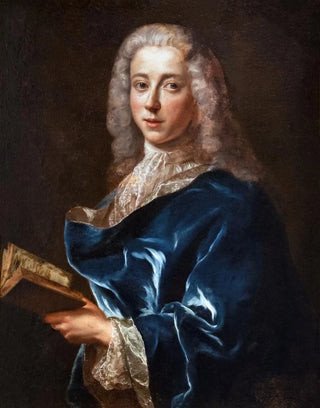Art print | Portrait of a man in a blue coat holding a book - Jean-François de Troy


View from behind

Frame (optional)
The "Portrait of a Man in a Blue Coat Holding a Book" by Jean-François de Troy is a work that transcends the simple frame of a portrait to invite a deep exploration of identity and the spirit of the 18th century. In this representation, the artist manages to capture not only the physical appearance of the subject but also an essence, a psychology that resonates through the centuries. The composition, rich in details and nuances, transports us into a universe where each element is significant, where every brushstroke tells a story. This portrait, through its majesty and delicacy, stands as a true testament to the era, a mirror of the aspirations and values of its time.
Style and uniqueness of the work
Jean-François de Troy's style is characterized by remarkable finesse and meticulous attention to detail. In this work, the blue coat of the subject, with its elegant drapes, almost seems to come alive under the keen eye of the viewer. The colors, carefully chosen, evoke both richness and simplicity, creating a harmonious balance that draws the eye. Shadows and lights are skillfully manipulated, giving an almost three-dimensional depth to the man's face. Holding a book, he symbolizes knowledge and wisdom, values dear to the Enlightenment era. This iconographic choice invites us to reflect on the role of the intellectual in society, while emphasizing the importance of education and culture. The composition, both classic and innovative, demonstrates technical mastery that places Jean-François de Troy among the great masters of portraiture.
The artist and his influence
Jean-François de Troy, born in 1679, established himself as an emblematic figure of French portraiture in the 18th century. Raised in an artistic environment, he developed a unique style that merges influences from his contemporaries while incorporating a personal touch. His career, marked by success, allowed him to work for influential personalities of his time, thus consolidating his reputation. De Troy also played a significant role in the development of the Royal Academy of Painting

Matte finish

View from behind

Frame (optional)
The "Portrait of a Man in a Blue Coat Holding a Book" by Jean-François de Troy is a work that transcends the simple frame of a portrait to invite a deep exploration of identity and the spirit of the 18th century. In this representation, the artist manages to capture not only the physical appearance of the subject but also an essence, a psychology that resonates through the centuries. The composition, rich in details and nuances, transports us into a universe where each element is significant, where every brushstroke tells a story. This portrait, through its majesty and delicacy, stands as a true testament to the era, a mirror of the aspirations and values of its time.
Style and uniqueness of the work
Jean-François de Troy's style is characterized by remarkable finesse and meticulous attention to detail. In this work, the blue coat of the subject, with its elegant drapes, almost seems to come alive under the keen eye of the viewer. The colors, carefully chosen, evoke both richness and simplicity, creating a harmonious balance that draws the eye. Shadows and lights are skillfully manipulated, giving an almost three-dimensional depth to the man's face. Holding a book, he symbolizes knowledge and wisdom, values dear to the Enlightenment era. This iconographic choice invites us to reflect on the role of the intellectual in society, while emphasizing the importance of education and culture. The composition, both classic and innovative, demonstrates technical mastery that places Jean-François de Troy among the great masters of portraiture.
The artist and his influence
Jean-François de Troy, born in 1679, established himself as an emblematic figure of French portraiture in the 18th century. Raised in an artistic environment, he developed a unique style that merges influences from his contemporaries while incorporating a personal touch. His career, marked by success, allowed him to work for influential personalities of his time, thus consolidating his reputation. De Troy also played a significant role in the development of the Royal Academy of Painting






